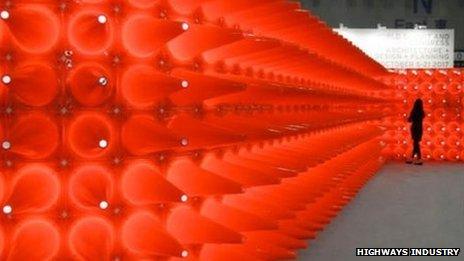Our love/hate relationship with traffic cones
- Published

Cones have been the focus of art installations
Following their introduction in the UK about sixty years ago, the humble traffic cone has permeated our lives - either as intended, as an instrument of traffic management or, perhaps, as part of a night of merry mischief.
Many people have a tipsy tale to tell of either themselves, or someone they know "borrowing" one on their way home from a night out.
Epitomised in an episode of the BBC TV comedy I'm Alan Partridge, when he goes on an unsuccessful mission to try to steal one, the orange and white pointy beacon seems to be inexplicably inviting to the intoxicated.
Such is their attraction to some, police forces up and down the country hold intermittent amnesties in an attempt to recover the pilfered pyramids.
Now the "intelligent" cone - which screams when moved or hit by vehicles - has been introduced by the Highway Agency in an effort to improve safety for road workers.
Midlands connection
But traffic cones also incite frustration, with rafts of them often the early warning sign for motorists of works and delays ahead, seemingly standing guard over an invisible workforce.
During John Major's premiership in the 1990s, a telephone line, or "cone hotline", was set up for motorists to complain about their unnecessary proliferation.
However, it was much derided at the time and gradually dropped off the government's and public's radar.
Bev Ward, from Hazard which develops road safety products in Birmingham, said the Midlands had been an important region for development of traffic management.
"This area has a bit of history for looking at traffic cones - Frank Myers in Redditch developed the flat cone about 20 years ago, winning a design award for it," he said.
"It's now called the Quickcone - it can be driven over and bounces back up.
"And there is David Morgan in Oxford who collects them. He has hundreds and worked for a huge plastics firms for years."

"Intelligent cones" will mainly be used on motorways, the Highways Agency said
Mr Morgan became a Guinness World Record holder when he collected 137 different traffic cones, which equated to about two thirds of all types ever made.
But Mr Ward said cones sell from about £4 but it was now hard for a company to make money from just selling them, with only a handful left in the UK.
"I don't know how a company could survive nowadays from just making cones, you need other products," he said.
He once wrote to the Department of Transport to ask why he was seeing so many cones doubled up - with one on top of another - at the side of roads.
"I asked them why, assuming it was down to their weight but they said it wasn't that because they tell the manufacturers what weight to make them."
He said the department later replied saying he was right at seeing the cones on top of one another but he was wrong about it being down to weight and stability. It was purely to keep the cones underneath clean.
Coloured cones
The orange and white cone is now joined by green, yellow and blue ones, recently introduced by the Highways Agency.
Green and white ones indicate access to a lane, yellow and white cones mean no stopping and blue and white cones denote an overhead structure, the agency said.
But it is the orange and white ones that have become the focus of art installations, as numerous images on the Highways Industry, external website shows.
So, from their beginnings as wooden or concrete cones, now the intelligent cone will soon be on a motorway network near you, somewhere that is hopefully out of reach of the inebriated.
- Published14 May 2013
- Published20 November 2010